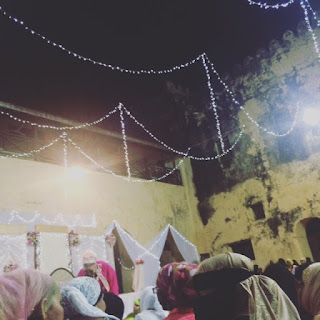 This month I had the pleasure of
attending a Swahili wedding ceremony at the Lamu Fort. This was a really interesting
experience, because the portion of the Swahili wedding tradition that I saw was
so different from a U.S.- style wedding.
This month I had the pleasure of
attending a Swahili wedding ceremony at the Lamu Fort. This was a really interesting
experience, because the portion of the Swahili wedding tradition that I saw was
so different from a U.S.- style wedding.
Swahili marriages are strongly
steeped in tradition and interestingly, very gender-segregated. In Muslim ceremonies, the woman does
not even attend the official “wedding” in the mosque. Instead, her father or brother represent her and sign the
marriage certificate. The portion
that I attended was the biggest party of the whole event, and it is only for
ladies.
Prior to the women’s event, a bride
is prepared by (traditionally) staying indoors for several weeks before the
wedding. There she is given many
beauty treatments by women in her family, and finally painted all over with
intricate henna and piko. The
resulting designs on her arms and legs are beautiful and take hours. Originally, only the bride would be
painted for a ceremony, but now it is custom for anyone attending the wedding
to be painted in celebration.
The wedding was a really
interesting and confusing experience for me. We entered the huge, open air fort in the center of town,
and even though we essentially remained outside, there was an air of privacy
and intimacy inside. I was dabbed
with perfumed oil and had incense wafted in my direction as I walked in, and
the whole place smelled like jasmine and incense. There was a large mirror by the door where women stopped to
remove their black buibuis and reveal the amazing rainbows of chiffon and silk
they had hidden underneath. There
were simple dresses and elaborate ones with tons of embellishment and long
trains, but they were all very colorful.
We all sat on chairs and mats in
the huge hall while a young girls’ choir sang saccharine Taarab music while
seated on the floor facing a large structure made of jasmine buds. Sometimes women would join to sing and
dance around them while waving folded 1000 shilling notes in one hand. After the song all the money would be
thrown into the jasmine centerpiece.
Women also fashioned hats and neckpieces out of folded cash and placed
them on important members of the party seated nearest to the choir. An elderly woman who must have been the
bride’s grandmother was so festooned with money accessories that she must have
had the equivalent of about 2000 USD on her person.
I was a little confused during all
of this, because there was no bride.
It was also getting late (around 10 pm) on a Sunday and the bride had
not appeared yet, so I was concerned.
How long would this ceremony take?
Finally, everyone turned and faced the back of the hall, and the bride
moved slowly down the aisle, severely impaired by her huge dress and the many
flowers attached to her. I was
watching her move slowly down the aisle when suddenly everyone moved towards
the exits and filed out. The bride
wasn’t even on the stage yet!
Apparently, once the bride appears, the rest of the evening is meant for
family only. Not being family, I
returned home and ate the lunch box I had been given. It was a very interesting event and I hope I am invited to
another!


































